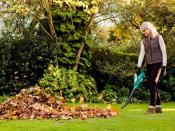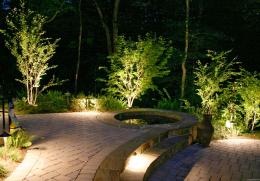Search
Login
Recommended
Do-it-yourself landscape lighting in the design of a garden plot, useful tips
If you plan to design landscape illumination of the site, which at first glance is intended only for decorating the territory, you can simultaneously cope with the solution of several fundamental problems: aesthetic and functional arrangement.
Content
- Functional and decorative lighting. The simultaneous solution of several tasks
- Basic techniques of landscape lighting. Types of fixtures
- Landscape Lighting Project. Highlighting paths in the garden video
- What you need to know about landscape lighting of trees?
- Lighting ponds. Landscape Lighting Control
Functional and decorative lighting. The simultaneous solution of several tasks
The purpose of the functional illumination of the garden is to light the access roads, the entrance to the garden, paths and ponds. Thanks to the organization of such lighting, absolute safety is achieved when moving around the site.

However, when arranging the garden lighting, it is important to choose and place the lighting devices correctly so as not to disturb the overall harmony of the garden design.

In addition to the fact that the landscape illumination of the summer cottage provides unhindered movement throughout the garden, it will add additional original notes to the night landscape, hide its imperfections and focus on its merits. Decorative garden lighting is designed to highlight key compositional elements with the help of a light stream to increase the aesthetics of the garden.

Basic techniques of landscape lighting. Types of fixtures
Experts say that the landscape illumination of a summer cottage can cover absolutely all the key elements of both design and architecture. The implementation of landscape lighting takes place in accordance with the peculiarities of the territory and obviously set tasks. For this purpose, fixtures with various typical characteristics can be used, which can be placed on supporting structures or directly in the ground. In connection with these requirements, there are several basic techniques of landscape lighting:

1. General reception. Its characteristic feature is the installation of crowning lamps equipped with shades with different configuration characteristics. Installation of such lamps can be carried out along garden paths, paved paths and areas intended for recreation;

2. Reception of marking backlight. Its use is justified in the case of lighting planning, the purpose of which is to establish fundamental lighting accents. In this case, the installation of lamps is made directly into the ground;

3. Reception of flood lighting provides for coverage of the territory along the entire perimeter. In order to deliberately exclude the blinding effect, the installation of lamps is carried out on high supports;
4. The emphasis technique is especially relevant for sites with an exquisite design, lighting for which is the main design element.

Designers suggest distinguishing between the following types of fixtures used in the development of landscape lighting:

1. Directional light, the purpose of which is aimed at creating a holistic composition and emphasizing its basic elements;
2. Illumination from below or in front of the object is used to illuminate plants, creating a bizarre shadow behind it;

3. Backlight, the essence of which is the illumination of an object from behind and the identification of its graphic silhouette;
4. The use of side light is practiced in the arrangement of backlighting of hedges or a variety of group plantings. It is designed to create expressive chiaroscuro, adding extra volume to the subject.

Landscape Lighting Project. Highlighting paths in the garden
If you decide to develop a landscape lighting project, you should know that, ideally, the lighting should extend to the entire site.

Moreover, before you start arranging the landscape illumination of the garden, you need to calculate the number and types of lighting devices, provide for the color characteristics of the lights used and think over the direction of the light fluxes.

An original design technique, which is desirable to observe when organizing landscape lighting, is the alternation of light and darkness, the contrast combination of which will create an exquisite play of spots of light and shadow. That is why, instead of continuous lighting, it is preferable to use selective illumination of individual functional areas.
Another important task that garden lighting is designed to cope with is the landscape illumination of paths in the garden. To solve this problem, special road lights are usually used, characterized by a luminous flux directed downward. In this case, the blinding effect is deliberately excluded.

Luminaires for which the described typical characteristics are characteristic are a good solution for decorating garden paths.

They are characterized by small dimensions and unique design solutions. An important feature of such lamps is dim light. To create the effect of scattered light along the tracks, a backlight is installed, characterized by the reflection effect.

To highlight garden paths, designers suggest installing low lights, the height of which does not always reach 1 meter. The lamps on them are protected by visors, characterized by a unique design solution, and rasters, the presence of which contributes to the required organization of the light flux. Thus, for the design of landscape illumination of paths in the garden, column lamps, called bollards, or reflected light lamps, the so-called indirects, are suitable. The know-how of modern compositional design has been the use of flat luminaires built into the road surface.

What you need to know about landscape lighting of trees?
If your site has many ornamental plants, such as thuja, juniper or even a hedge of hawthorn, then you need to think about landscape lighting of trees and plants. When arranging such lighting, it is important to consider the texture characteristics of tree trunks, the density or transparency of the crown, as well as the shape of the leaves.

If the tree is characterized by the presence of a thick and opaque crown, the fixtures are installed at a considerable distance from the object of illumination in order to provide an external flood light of the crown. Openwork crown with high transparency makes it necessary to install lamps next to the illuminated object. This allows you to create interior lighting for the crown and achieve a bewitching glow of leaves.


Lighting ponds. Landscape Lighting Control
Lighting of reservoirs is an important aspect of the design of garden lighting. The choice of luminaires, which are the main illumination link for water bodies, depends on their functional purpose: lighting the water surface or lighting the shores of a water body. To illuminate individual elements of a reservoir of plants or stones, spotlights are suitable.

When organizing illumination of a specular water surface, recently used floating lamps in the shape of a ball, combined by a cable. The technique of arranging coastal luminaires contributes to the illumination of not the entire surface of the reservoir, but only selective emphasis on individual sections.

The choice of lighting for ponds depends on the transparency of the water. Cold light bulbs with a bluish tint are suitable for illuminating perfectly transparent reservoirs, while for muddy sources it is advisable to use lamps with a yellowish-white glow that perfectly shades the vegetation.

Management of landscape lighting devices is carried out manually and automatically. If you decide to give preference to manual control of the backlight, experts advise you to organize separate switches for each individual functional area or element. The automatic control system is regulated by a timer, at a certain time, turning on and off each separate structural and functional zone.







